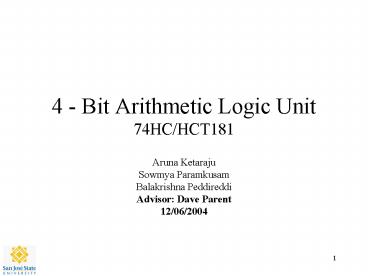4 Bit Arithmetic Logic Unit 74HCHCT181 - PowerPoint PPT Presentation
1 / 20
Title:
4 Bit Arithmetic Logic Unit 74HCHCT181
Description:
We designed a 4-bit Arithmetic Logic Unit that operates at 200 MHz and uses ... The DFF drives a load of 14.5fF and based on that the Wns and Wps are calculated. ... – PowerPoint PPT presentation
Number of Views:67
Avg rating:3.0/5.0
Title: 4 Bit Arithmetic Logic Unit 74HCHCT181
1
4 - Bit Arithmetic Logic Unit74HC/HCT181
- Aruna Ketaraju
- Sowmya Paramkusam
- Balakrishna Peddireddi
- Advisor Dave Parent
- 12/06/2004
2
Agenda
- Abstract
- Introduction
- Design Process Methodology
- Logic Verification
- Worst-case Delay Calculations
- Results
- Cost Analysis
- Conclusions
3
Abstract
- We designed a 4-bit Arithmetic Logic Unit that
operates at 200 MHz and uses 20.3W/cm2 of Power
and occupies an area of 710x340mm2. - Full look-ahead for high speed operation on long
words. - Arithmetic operating modes
- -Addition, Subtraction
- Logic function modes
- - NAND, AND, OR, NOR, EX-OR, Comparator plus
ten other logic operations.
4
Introduction
- The 74HC/HCT181 is a 4-bit ALU.
- Controlled by S0, S1, S2, S3, M.
- For M High , Logical operations are performed
- For M Low Cn High, Arithmetic operations
are performed. - It can perform 16 arithmetic and 16 logical
operations.
5
Design Process Methodology of the ALU
- Sizing Transistors through the use of analytical
equations. - Cell-based circuit implementation.
- Simulation.
- Layout.
- Design Rule Check.
- Layout versus Schematic Check.
- Extraction.
- Post Simulation
6
Logic Diagram Philips 74HC/HCT181
7
(No Transcript)
8
DFFs
- DFFs are placed on either side of the
combinational logic. - The DFF drives a load of 14.5fF and based on that
the Wns and Wps are calculated. - The set-up and hold-times are .59ns and .63ns
respectively.
9
Longest Path Calculations
Note All widths are in microns and capacitances
in fF
10
SCHEMATIC
11
Functions performed by ALU
12
Logic Verification
13
LAYOUT
14
Verification
LVS REPORT
15
Worst-case Delay Calculations
- Longest Path is between B2 and AB.
- The test vectors to calculate the worst-case
propagation delay are - A0, A1, A2, A3, B0, B1, B3, S1 0
- M, Cn 1
- B2 toggle
16
Simulations
17
Cost Analysis
- Time spent on each phase of the project
- Verifying logic 3days
- Verifying timing 7days
- Layout 15days
- Post extracted timing 7days
18
Lessons Learned
- Every PMOS should be in contact with n-tap.
- Never route with poly.
- The input data shouldn't near the clock rising
edge.
19
Conclusions
- 4-bit ALU has been simulated and verified
- Frequency, area and power specifications have
been met.
20
Acknowledgements
- Thanks to Cadence Design Systems for the VLSI lab
- Thanks to Synopsys for Software donation
- Thanks to Prof. Parent for his support and
guidance in each and every step of the project.

